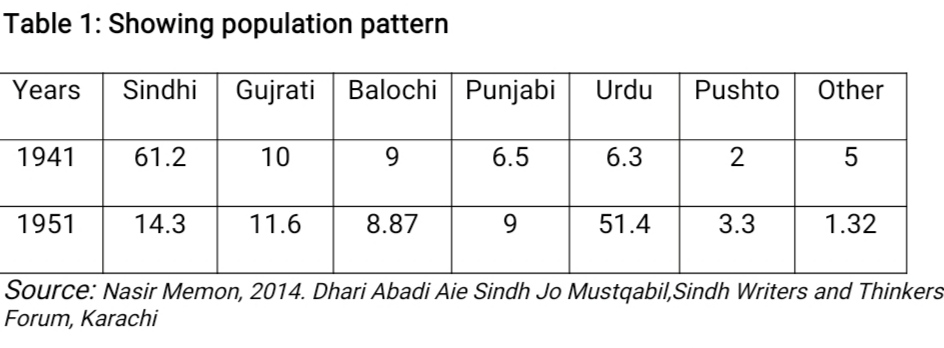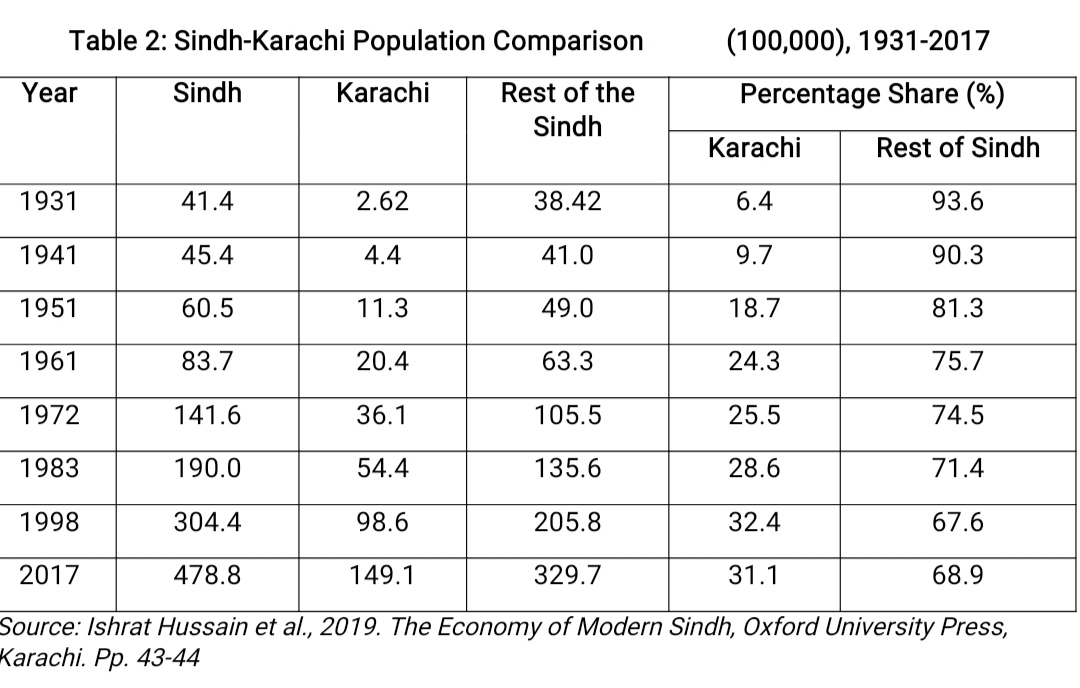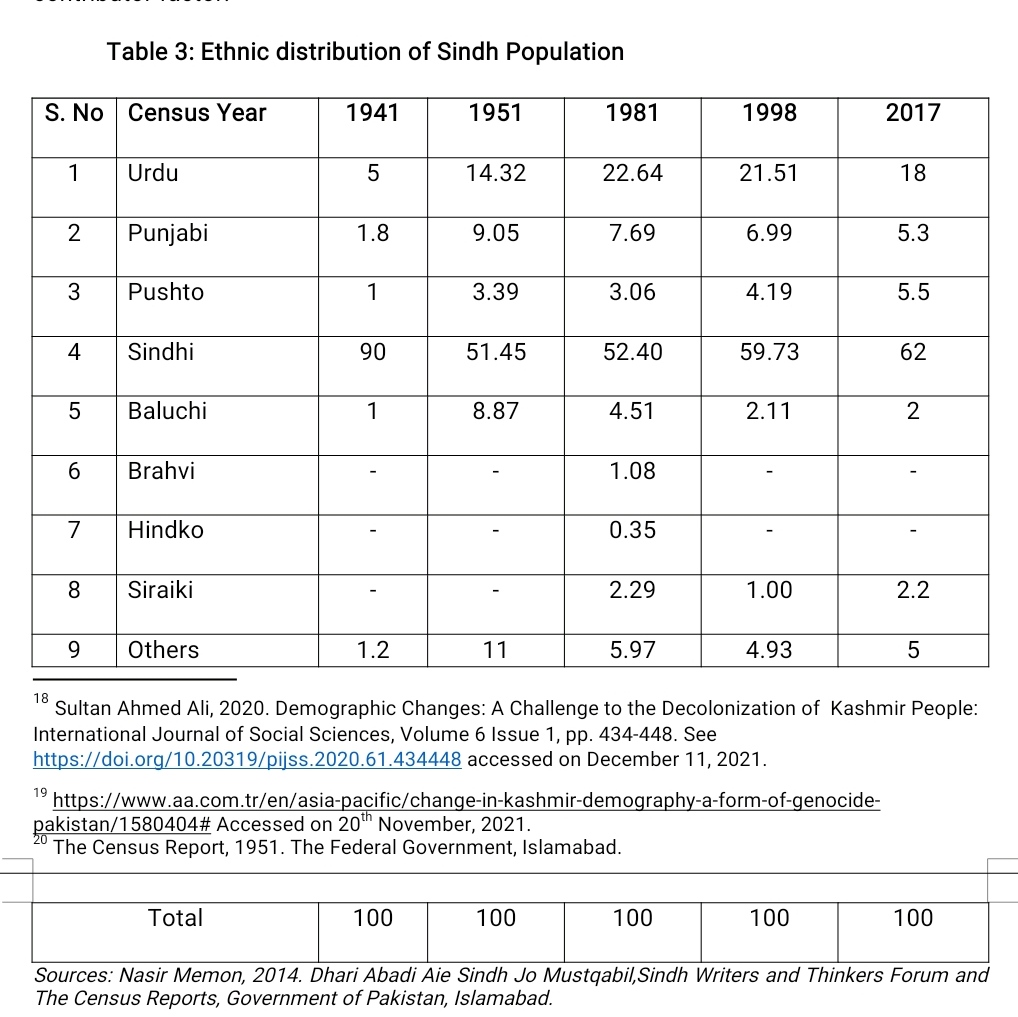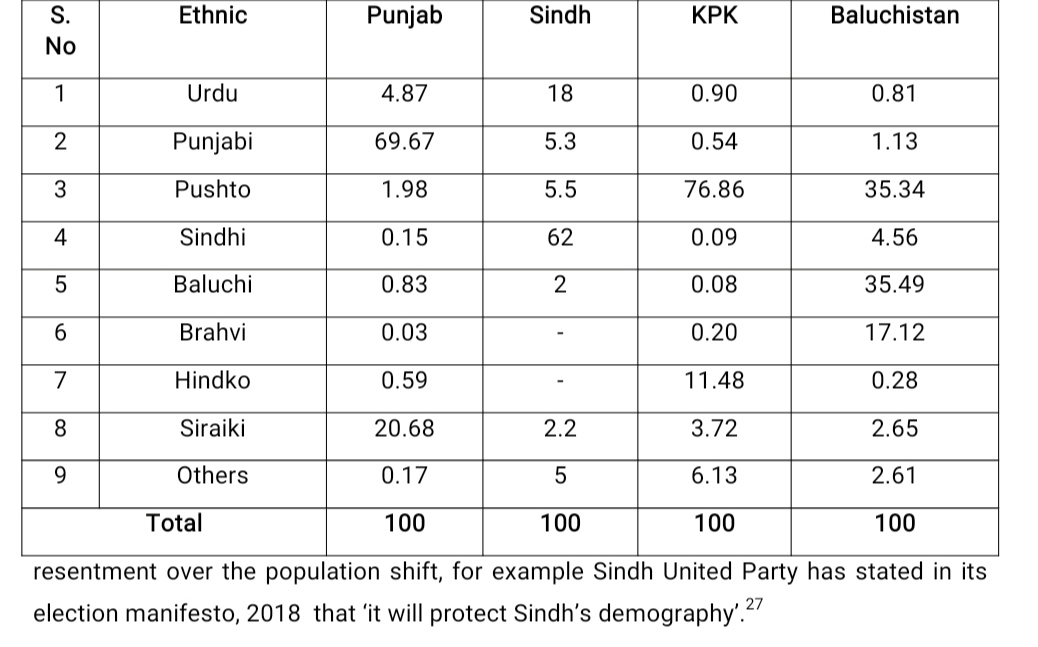
The simple statistics reveals that Karachi’s share in total population in 1931 was 6.4%, and the rest of Sindh’s share was 93.6%. But after roughly 90 years, the census of 2017 shows that Karachi has 31.1% and the rest of Sindh’s total population of Sindh is 68.9%.
By Mushtaq Mirani
[This paper defines demographic engineering, and explains its forms. It also explores how some of its forms are being applied in Sindh Province, Pakistan. It traces and unpacks how from 1947 to 2017 all successive federal and provincial governments have played their part in implementation of some of the demographic engineering policies. In addition to it, the article also focuses on the nature of Pakistan’s federation, and its subtle ways and means of population migration from other provinces to Sindh province and particularly to its city centers. The article has also spotlighted on internal and interprovincial migration factors, and has highlighted some natural factors. The article concludes that how steady demographic engineering and its various subtle mechanisms have threatened Sindhis to become a minority and lose the natural claim of their land, Sindh]
Demographic engineering definitions, concepts and explanations
Demographic engineering is defined as a deliberate effort to shift the ethnic balance of an area, especially with a political motivation measures for create ethnically homogeneous populations. In specific explanation demographic engineering term deals with population transfers, it included forced migrations. The most practiced forms of demographic engineering are a) population transfer, b) genocide, c) ethnic cleansing, d) inducement migration and e) policies for demographic engineering. Moreover, to some extend demographic engineering concept covers falsification of census results, redrawing borders, changing in birth rates of particular population groups, with voluntary or coerced emigration. However, genocide is an extreme form of demographic engineering.
 It is pertinent to explain these demographic engineering forms in detail. The demographic engineering in specific geographic areas creates winners, losers, conditions governance, employment and social services and controls strategic locations. It also re-shapes human settlement in particular geographical pockets. However, the ‘genocide’ term unpacks itself as an intentional action to destroy people. Likewise, ‘ethnic cleansing’ deals with the expulsion, imprisonment, or killing of an ethnic minority with a purpose to achieve ethnic homogeneity. Similarly, ‘population transfer’ is one of the forms of the population shift. However, it is also called resettlement, where a large group of people moves from one region to another. In most of the cases, the forced migration imposed by state policy or authority. Another form is called, ‘inducement migration’ it is a particular situation that operates through ‘pull’ and ‘push’ factors. The demographic engineering applies a certain set of policies. The policies are population measurement (census politicization), assimilation, boundary changes, economic pressure (inducement), ethnic dilution, ethnic consolidation and the policies are used by the states or the governments to drive away undesirable ethnic population and consolidate the desired population.
It is pertinent to explain these demographic engineering forms in detail. The demographic engineering in specific geographic areas creates winners, losers, conditions governance, employment and social services and controls strategic locations. It also re-shapes human settlement in particular geographical pockets. However, the ‘genocide’ term unpacks itself as an intentional action to destroy people. Likewise, ‘ethnic cleansing’ deals with the expulsion, imprisonment, or killing of an ethnic minority with a purpose to achieve ethnic homogeneity. Similarly, ‘population transfer’ is one of the forms of the population shift. However, it is also called resettlement, where a large group of people moves from one region to another. In most of the cases, the forced migration imposed by state policy or authority. Another form is called, ‘inducement migration’ it is a particular situation that operates through ‘pull’ and ‘push’ factors. The demographic engineering applies a certain set of policies. The policies are population measurement (census politicization), assimilation, boundary changes, economic pressure (inducement), ethnic dilution, ethnic consolidation and the policies are used by the states or the governments to drive away undesirable ethnic population and consolidate the desired population.
Resolution of 1940 and Nature of Pakistan’s Federation
In present times, demographic engineering takes place through various means. A lead one is the constitutional provisions. However, in the case of Sindh prior to have critical is important to dissect the Pakistan resolution, 1940. Prior to become an administrative part of the British Empire Sindh was an independent state till 1843.
Resolution of 1940
The political leadership of 1930s and onwards strived to secure the rights of people. One could list lot example of peoples’ movements, but separation of Sindh from the Bombay Presidency was one the lead movements that set new standards in Sindh’s politics. Later on, Sindh Muslim League’s popularity also should be considered in that direction. Resultantly, a majority of Sindhis considered ‘1940’s Lahore Resolution’ as a salvation, because it declare:
‘No constitutional plan would be workable or acceptable to the Muslims unless geographical contiguous units are demarcated into regions which should be so constituted with such territorial readjustments as may be necessary. That the areas in which the Muslims are numerically in majority as in the North-Western and Eastern zones of India should be grouped to constitute independent states in which the constituent units shall be autonomous and sovereign”.
It further reads:
“That adequate, effective and mandatory safeguards shall be specifically provided in the constitution for minorities in the units and in the regions for the protection of their religious, cultural, economic, political, administrative and other rights of the minorities, with their consultation. Arrangements thus should be made for the security of Muslims where they were in a minority”.
Types of Federation and Pakistan
The federation is defined that ‘the federation is formed when two or more than two nation entities are combined for larger gains and larger political unit is formed. Generally, there are three types of processes or intentions of the formation of the federation. These are: ‘coming together’, ‘holding together’, and ‘putting together’. The USA is an example of ‘coming together’ type of the federation. Likewise, the Germany represents ‘holding together’ model. In this way, Pakistan and Nigeria are examples of ‘putting together’. It is called so, because the political model was imposed on the constituent units.
Population Transfer, intention, design and ways – case of Karachi city
Sindh became part of the newly formed federation called as ‘putting together. But the federal government immediately implemented its ‘population transfer policy’. It applied multiple steps, one of them was to declare Karachi as a newly formed state’s capital. The move constrained relation in between the central government and Sindh Government. Professor Aisha Jalal adds:
‘the center’s advocacy of the Urdu-speaking migrants’ right to space……. was perceived as a deep-seated conspiracy to displace Sindhis from a position of dominance in their own province”.
The politically motivated move adversely affected the population pattern of Sindh, especially of Karachi city. The below mentioned shows the population pattern, after the federal government’s decision of making Karachi city as the capital of Pakistan. The table has displayed figures of two census reports – 1941 and 1951.
 Onward, relations between the central government and Sindh Government were strained. Immediately, settlement of the refugees in Karachi reached its maximum level. Soon refugees attacked Sindhi Hindus who constituted 30% of the Sindh’s population, resided in urban area, afterwards they migrated to India. Sindh declared that it would only accept 150,000 refugees in Sindh. Finally, the Sindh assembly made unanimous resolution to oppose this plan on 10th February 1948. Subsequent development occurred in which premier of Sindh Ayub Khuhro was dismissed. The migration continued and it changed the population pattern in urban-Sindh, particularly of Karachi city. The unnatural population transfer triggered two processes sharp rise in Sindh’s total population, and dramatic shift in Karachi’s population. The census data of 1941 and 1951 census shows that population of Karachi reached 10,055,000. However, in the previous census it was merely 436,000. The population of Karachi city and reset of Sindh is mentioned in the blow table.
Onward, relations between the central government and Sindh Government were strained. Immediately, settlement of the refugees in Karachi reached its maximum level. Soon refugees attacked Sindhi Hindus who constituted 30% of the Sindh’s population, resided in urban area, afterwards they migrated to India. Sindh declared that it would only accept 150,000 refugees in Sindh. Finally, the Sindh assembly made unanimous resolution to oppose this plan on 10th February 1948. Subsequent development occurred in which premier of Sindh Ayub Khuhro was dismissed. The migration continued and it changed the population pattern in urban-Sindh, particularly of Karachi city. The unnatural population transfer triggered two processes sharp rise in Sindh’s total population, and dramatic shift in Karachi’s population. The census data of 1941 and 1951 census shows that population of Karachi reached 10,055,000. However, in the previous census it was merely 436,000. The population of Karachi city and reset of Sindh is mentioned in the blow table.
 The simple statistics revealed that Karachi’s share in total population in 1931 was 6.4%, and the rest of Sindh’s share was 93.6%. But after roughly in 90 years, the census of 2017 stated that Karachi has added 31.1% and the rest of Sindh’s contribution in total population of Sindh was 68.9%. Another calculation shows that over the period (1931-2017) population of the Karachi city has jumped 24.7%. Therefore, Sindhi’s feared that after some years Karachi’s population might take over the rest of Sindh population. It happens so then Sindh would be majority province of migration population.
The simple statistics revealed that Karachi’s share in total population in 1931 was 6.4%, and the rest of Sindh’s share was 93.6%. But after roughly in 90 years, the census of 2017 stated that Karachi has added 31.1% and the rest of Sindh’s contribution in total population of Sindh was 68.9%. Another calculation shows that over the period (1931-2017) population of the Karachi city has jumped 24.7%. Therefore, Sindhi’s feared that after some years Karachi’s population might take over the rest of Sindh population. It happens so then Sindh would be majority province of migration population.
The Central Government’s delicate designs
Nowadays, population transfer is neither local issue nor naïve attempt. It is global phenomena, and serious academic writings quote such moves around the globe. Milica Zarkovic Bookman calls it ‘a global war of numbers’. She elaborates that ‘[war of numbers] increase the economic and political power of an ethnic group relative to other group, and the method by which is achieved entails the increase in size of the one population relative to others.’ The majority group, in case of Pakistan’s central government applied ‘subtle components’ for realization of the population shift mechanism. The global literature reveals that such ‘mechanism’ might involve resettlement policies, allocation of lands, internal-migration polices, and even religious conversion. In the case of Sindh, some of subtle ways were: legislation, constitutional frames. One the relevant example is of the BJP, it attempted convert the Muslim majority in Indian-Occupied Kashmir into minority through demographic engineering. It modified article 370 and article 35A of the Indian Constitution. In addition to that the BJP government has initiated lot mega projects that are attracting investors, and started migration. The continued Indian Government’s demographic engineering was notices by the Pakistan Government. Its Foreign Minister’s (Shah Mehmood Qureshi) statement appeared in the media, and called the demographic change in Kashmir as genocide.
In this regard, imposition of one-unit scheme in 1955 is an ideal example. First, it provided legal covered to refugee claims (building and asset vacated by migrated Hindus), and opened windows people of other provinces to get Kotri barrage land and Gudu barrage land. On parallel move, almost all successive governments invested in urban pockets of Sindh. Resultantly, people from other areas migrated to Sindh, especially in its urban center. In this case, Karachi city, involuntarily hosted more people. The consecutive censuses reveal that along with Karachi city, the population of Sindh also unnatural way increased added. However, migration of Sindhi Hindus was also lead contributor factor.
 Resultantly, Sindh’s population was affected. In 1941 Sindhis population was 86% and in 2017 it was reduced to 61%. Apart from political engineering, there are other mechanisms that initiate migration to Sindh are ‘push/pull factors’. However, in the case of Sindh ‘pull factors’ compel the people from other areas to migrate, and settle in Sindh. However, in the case of Sindh, an internal migration was caused due to various reasons. However, one of them was rapid industrialization in Pakistan, including in Karachi, Hyderabad and other cities of Sindh.
Resultantly, Sindh’s population was affected. In 1941 Sindhis population was 86% and in 2017 it was reduced to 61%. Apart from political engineering, there are other mechanisms that initiate migration to Sindh are ‘push/pull factors’. However, in the case of Sindh ‘pull factors’ compel the people from other areas to migrate, and settle in Sindh. However, in the case of Sindh, an internal migration was caused due to various reasons. However, one of them was rapid industrialization in Pakistan, including in Karachi, Hyderabad and other cities of Sindh.
The investment created huge demand of employment opportunities, and it also aligned with population shift idea of the federal government. Altaf Gohar has quoted Choudhry Muhammad on ‘outsiders’ issue in Sindh, which also endorses the policy of the federal government. It reads:
“His (Choudry Muhammad Ali) government in the 1950s had foreseen the problem and had planned the induction of Mohajirs into Karachi and other major towns of Sindh to forestall Sindhi nationalism’.
Therefore, migrants from Punjab and Khyber Pakhtunkhwa were encouraged and facilitated. Later on disposal of Kotri barrage and Gudu barrage land to non-Sindhis attracted migration to Sindh. In Sindh mostly inducement and push factors accelerate migration to Sindh like job opportunities, moderate climate support of host communities and facilitation of federal and Sindh government to migration like regulation of (Katchi Aabadi). In case this induced policy is mingled with other factors such as economic factors, social factors, health services it accelerates the migration, and it paves the way for climate threat and food insecurity.
On other hand, population in other provinces has remained natural. The analysis of 2017 census shows that except to Sindh other provinces have stable demographic pattern. In case of Punjab, Punjabi were 69.67% and Siraiki’s were 20.68%. Likewsie, in Khyber Pakhtunkhwa, 76.86% were Pushto speaking and Hindko’s were 11.48%. Similarly, in Baluchistan, Baloach were 35.34%, Pushton were 35.34% and Brahvi were 17.12%. However, in Sindh which had almost 90% Sindhi speaking people in 1941, now there it has reduced to 62% in the census of 1917.
Table 4: Ethnic distribution in Pakistan, 2017 census
 It is alarming that in all federation units only Sindh’s demography has been drastically changed. The recently published literature literate has coined a new term for the population transfer, which is called ‘Ethnic Dilution’. In that process, population of a particular ethnic group is shifter in order to dilute the specific population. In such shifting skills categories or income groups are not considered, but ethnicity is considered with a goal of diminishing the political and cultural strength of the targeted group. It has huge impact on politics, economy, natural resource, employment, poverty and social psychology. On the other hand, the migrant population has sent its representative in Sindh assembly and National assembly. A deluge of non-local population in Sindh and Baluchistan has raised the anxieties of the native population; the data of 2017 census explain the reason. Sindhi speaking were approximately 60% in their respective province. On the other hand, Sindh based political parties have shown resentment over the population shift, for example Sindh United Party has stated in its election manifesto, 2018 that ‘it will protect Sindh’s demography’.
It is alarming that in all federation units only Sindh’s demography has been drastically changed. The recently published literature literate has coined a new term for the population transfer, which is called ‘Ethnic Dilution’. In that process, population of a particular ethnic group is shifter in order to dilute the specific population. In such shifting skills categories or income groups are not considered, but ethnicity is considered with a goal of diminishing the political and cultural strength of the targeted group. It has huge impact on politics, economy, natural resource, employment, poverty and social psychology. On the other hand, the migrant population has sent its representative in Sindh assembly and National assembly. A deluge of non-local population in Sindh and Baluchistan has raised the anxieties of the native population; the data of 2017 census explain the reason. Sindhi speaking were approximately 60% in their respective province. On the other hand, Sindh based political parties have shown resentment over the population shift, for example Sindh United Party has stated in its election manifesto, 2018 that ‘it will protect Sindh’s demography’.
Conclusion
The demographic engineering, induced migration and other forms of population transfer to Sindh is well-thought mechanism. It was one of the regular features of the federal government and the provincial government. The apparent reasons of the population shift are exclusion dilution of Sindhis in their own province increase the numerical number of the desirable ethnic group, occupation of strategic lands, water and other security needs controlling strategic cities, towns and security location. Therefore, it seems that the state’s demographic engineering policy intends to achieve the objective of one nation one territory. If it so, then it is against the spirit of the Pakistan Resolution, 1940. And consequently, Sindh would lose its old identity, and it would be converted into minority, strategic locations such coastal belt and other resources would be taken away from it. In the continuity of such policy more non-Sindhis members would be inducted into Sindh assembly, national assembly and senate. Therefore, Sindh wouldn’t be in position to strive for its right of self-determination. Currently there are several projects initiated by the Pakistan Government, Sindh Government and private foundation (Bahria Town, Defence Housing Authority, (DHA), China-Pakistan Economic Corridor (CPEC) etc.) might influx people from other provinces and even from Afghanistan. Most of them will migrate to Karachi, Jamshoro, Hyderabad and Thatta district. Therefore, immediate remedy needed to hold article 15 article and article 23for considerable time. It is being demanded because, the Article 15 states:
‘Freedom of movement, etc. Every citizen shall have the right to remain in, and, subject to any reasonable restriction imposed by law in the public interest, enter and move freely throughout Pakistan and to reside and settle in any part thereof’.
Likewise Article 23 supports the previous article, while its states:
‘Provision as to property. Every citizen shall have the right to acquire, hold and dispose of property in any part of Pakistan, subject to the Constitution and any reasonable restrictions imposed by law in the public interest.
On the other hand, it is obligation of the federation government to protect interest of the federating units. It must be realized that the provincial government couldn’t play any role because the constitution limits role. Presently, lot of Sindh based political parties raised their voice against this population shift.
_____________________
About the Author
 Mushtaq Mirani is a retired Associate Professor. He worked in Mehran University of Engineering and Technology, Jamshoro. He could be accessed at mirani55@gmail.com
Mushtaq Mirani is a retired Associate Professor. He worked in Mehran University of Engineering and Technology, Jamshoro. He could be accessed at mirani55@gmail.com
(The author has presented this paper at 3-day International Conference on ‘Democratic Federalism’, organized by Shah Abdul Latif University Khairpur on December 15-17, 2021)